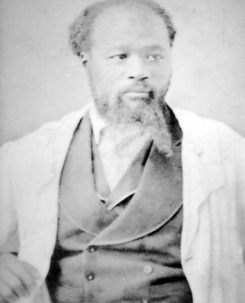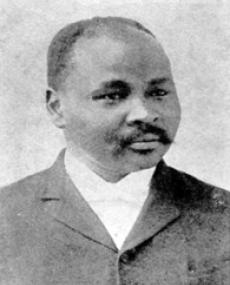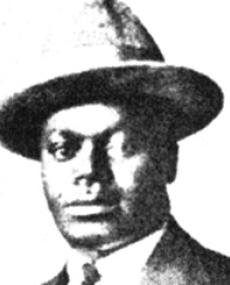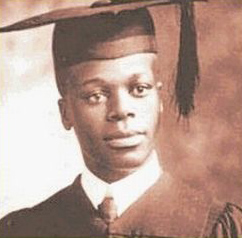John Langalibalele Dube was born at Inanda Mission station of the American Zulu Mission (AZM) in Natal on 11 February 1871 to James and Elizabeth Dube. ‘Langalibalele’, his middle name, means ‘bright sun’. Dube’s grandmother, Dalitha became the first convert of the Lindley Mission Station in Inanda, in the late 1840s. She wanted a clear separation from the traditional AmaQadi way of life. The Christian way of life was perceived and associated with ‘freedom, education and civilisation’. Consequently, James Dube (John Dube’s father) himself became a religious minister and became a leading figure in the Amakholwa (converts) section of the AmaQadi tribe.
 Photograph of John Dube's father Reverend James Dube. Source, Ohlange Interpretation Centre.
Photograph of John Dube's father Reverend James Dube. Source, Ohlange Interpretation Centre.
Dube’s mother, Elizabeth, was from the Tshangase chiefdom and her traditional name was Namazi Shangase – she was given the name MaShangase after her children were born. Dube had seven siblings: Nomagugu (the first-born, a daughter), Victoria, Esther, Hleziphi, Africa (the first-born son), William and Thupana.
Rev James Dube (who died in 1877) was also one of the minor Zulu chiefs of the AmaQadi tribe and one of the first ministers ordained by the AZM. Thus, John Dube was born of royal lineage, and by right was a chief of the AmaQadi tribe. It was only because Dube’s father was converted to Christianity by the early missionaries that he did not rule over his AmaQadi people. There was conflict between the introduction of western education by the missionaries and the traditional African society’s way of life.
He spent his early schooling years at Adams School at the Inanda station, where his father James Dube served as a Congregational Minister. Missionaries played an important role in shaping the social and political scene in South Africa. The missionary influence was both positive and negative, and Dube stands out as a typical example of both influences. While mission education helped Dube develop a strong grasp of the English language, missionaries also attempted to culturally indoctrinate their indigenous subjects. This is evidenced by Dube’s generally critical view of his ‘native land’ later in his life.
While he was at school, on one occasion, Dube got into some trouble with other boys at his school, and the school’s Reverend Goodenough approached his colleague, William Wilcox, who was based at Inhambe, to come and have a talk to the boys. From this encounter, Dube and Wilcox developed a relationship.
Dube asked Wilcox if he could accompany him to Oberlin College on his return to the United States. Wilcox agreed, but warned Dube that he would have to earn money to pay for his education. Dube claimed to have saved some money while working as a miner, although it is believed that his mother gave Wilcox a total of thirty gold sovereigns to take Dube to the United States. This amount of money was however not sufficient to sustain Dube during his stay in the US. Consequently, Dube earned money doing outdoor labouring jobs, but after expressing his dissatisfaction, Wilcox introduced him to Mrs Frank H Foster, who used her connections in Oberlin to find more suitable work for the student.
 Varushka Jardine (SAHO), Lulu Dube (centre) and Nasreen Khan (SAHO), Ohlange Institute Durban, 17 October 2011. © SAHO
Varushka Jardine (SAHO), Lulu Dube (centre) and Nasreen Khan (SAHO), Ohlange Institute Durban, 17 October 2011. © SAHO
During 1887 and 1888, Dube worked at the Oberlin College as a cleaner, and did odd jobs for the students. From 1888 to 1890, Dube enrolled at the Oberlin preparatory school to study the sciences, mathematics, classical Greek works, and a course in oratorical skills. Throughout this period, Dube experienced great difficulty maintaining a steady job while studying at the same time. Although Dube never received an official degree from Oberlin College, the skills, connections and worldly perspectives which he cultivated during these years laid the foundations for his later accomplishments.
Wilcox left Oberlin to take up the position of a pastor in New York, and invited Dube to visit him there. During this visit Dube assisted Wilcox in printing a pamphlet entitled
Self support among the kaffirs. The pamphlet emphasised Wilcox’s belief that industrial education was the best way to uplift the native people of Africa. The concept had a profound influence on Dube, to the extent that it would result in the founding of the Ohlange Institute ten years later.
While in the US, Dube was given the opportunity to lecture while accompanying Wilcox on his lecture tour. He lectured from 1890 to 1892, delivering talks throughout Ohio, Pennsylvania and New York. Dube succeeded in raising a sum of money which was later used to start a school in South Africa. During this time Dube published a book called
A Familiar Talk Upon My Native Land and Some Things Found There. The work reflected the conflict Dube experienced as a mission-educated indigenous person struggling to find a balance between his traditional ethnic roots and Christian teachings. But the publication also reflected Dube’s motivation to produce literature and exhibited his writing skills, which would serve him well in leading indigenous people in articulating the battle for their rights.
A chronic illness forced Dube to return to South Africa in 1892, a year after Wilcox had returned to work at a mission station at Groutville. On his return, Dube taught at his former high school in Amanzimtoti, where he met Nokutela Mdima, who he later married. Again, Dube and Wilcox found themselves working together, but Dube became increasingly unhappy with the structure of traditional mission education. In 1894, Dube was encouraged by Wilcox and Nokutela to establish his own mission. This spurred him on to establish a small day school in Incawadi Village in the Umkhomazi Valley, where he taught English and mathematics. In an attempt to transform and Christianise the village, Dube built two churches between 1894 and 1896. Dube’s school differed from other missionary schools: the learners were encouraged to read in their own language as well as to concentrate on practical aspects of the curriculum.
In 1897 Dube returned once more to the US for further training, this time accompanied by his wife. He enrolled at the Union Missionary Seminary in Brooklyn, in New York. In March 1899, Dube was ordained as a priest by the Congregational Church. During this visit Dube was profoundly influenced by Booker T Washington, whose ideas dominated Dube’s educational and political thoughts. Both Dube and Washington were inspired by the motto ‘learning and labour’, which Oberlin College had adopted. Both men were considered civil rights activists, educators and writers. Washington encouraged his students at Tuskegee to become self-reliant by teaching them skills such as printing, farming, shoemaking, and cooking, amongst others. This inspired Dube to develop a similar kind of initiative aimed at advancing the rights of Black people when he returned to South Africa. In August 1900 he established the Zulu Christian Industrial Institute which was renamed the Ohlange Institute in 1901. The institute functioned as a school where African children obtained education.
Perhaps, more importantly, on his return, Dube established links with like-minded leaders to form the Natal Native Congress (NNC) in July 1900. This was the beginning of his commitment to political action. The aim of the NNC was to find a way whereby black peoples’ feelings, aspirations, and grievances could be brought to the attention of the colonial government. The concerns of the NNC centred around the following issues:
- Unobstructed land ownership
- Education
- Parliamentary representation
- Free trade
- Freedom from enforced labour
The Congress became the main political organ of the Black people throughout the period that Natal remained a separate colony. Through the NNC, Dube advocated equality and justice for all. He hoped to close the widening gap between the Whites and Blacks of South Africa. He played a leading role in Black resistance to the Union of South African states, from whose legislature Blacks were to be excluded.
The skills of editing and publishing that Dube developed, while working at a local printing firm in the US, were put to good use when he established the first indigenous Zulu newspaper,
Ilanga Lase Natal. Officially launched in April 1903, Dube’s aim in establishing the newspaper was for it to be a mouth-piece for the black population, and to propagate the idea of a united African front.
Ilangaexpanded on Washingtonian ideas of self-sufficiency and self-segregation. Dube used his newspaper to expose injustices and evil deeds from all quarters and made black people aware of their rights and privileges. Initially the paper was printed by International Printing Press in Durban, but from October 1903 (the 25
th edition) it was printed at Ohlange itself.
Ilangawas financed from donations and funds which Dube received from associates and friends in the US. There was little evidence of any influence from the American Zulu Mission in the newspaper. Occasionally he would feature editorials and articles in English which were intended for the white settler community, the department of Native Affairs and the Natal Government. Dube hoped in this way to keep them connected to black opinion at the time. As time progressed, black people used the newspaper to criticise government policies. At one stage Dube was accused by the authorities for inciting resentment against the government.
Ilanga Lase Natalfocussed on issues pertaining to:
- Land controversies (including taxes and land ownership);
- Laws and acts, such as the poll tax;
- Reports such as those of the South African Native Affairs Commission;
- Political and social developments.
When Dube returned from the US in 1905 (after his third visit), tensions arose between him and the white missionaries.
Ilanga lase Natal attacked the missionaries’ views on land allotment on the Reserves, the Mission Reserve rent, the social aloofness of missionaries and their lack of trust for the converts, inadequate selection of African officers and failure to defend African interests. By September 1906, Dube was calling for a meeting of the Transvaal, Cape and Natal congresses and ‘welcoming signs that tribal antagonisms are dying down as indications of progress’.
In 1906 the
Bambatha Rebellion broke out. It was triggered largely by an introduction of new taxes, and also the encroachment of white settlers on land owned by Africans. Dube had followed the debate regarding the poll tax in Parliament and was extremely aggrieved that the government had not consulted with kholwa spokesmen or chiefs on the matter. He noted in his newspaper that the economic situation of Blacks would not allow them to pay the tax without considerable suffering. He argued that the tax was unfair as Blacks were not represented in Parliament.
Despite his opposition to the tax, Dube did not support the rebellion. He wanted to avoid violence at all costs and wanted the government to know that the
kholwa would always remain loyal to the government and that they had no reason to rebel. In Dube’s own words: ‘the loyalty of the natives is beyond dispute’. He made it known that the kholwa still identified with the values of the White man and wished to be seen as equals to Whites.
However, Dube bitterly opposed the arrest and trial of
Dinizulu in connection with the rebellion and actively assisted in raising funds for his defence. Dinizulu, son of the last Zulu king, was for Black people in South Africa the symbol of their former independence and their identity as a people. Dube, with his recollections of and pride in his African past, understood the significance of Dinizulu and his place in Zulu history. Dube publicised Dinizulu's arrest. The Natal government attempted to suppress
Ilanga Lase Natal before and during the
Bambatha Rebellion – the newspaper was the object of constant suspicion.
Dube tried to use his influence during the rebellion by visiting and talking to Zulu chiefs to get their people to keep the peace. Dube had no desire to end British rule and the spread of Christianity, and Bambatha represented the heathen way of life, something Dube had no desire to return to.
Another reason for Dube’s endorsement of the colonists’ reaction to Bambatha was based on the economic and the political status of Blacks throughout Natal. Some colonists saw the rebellion as an opportunity to grab the land of Blacks who supported Bambatha and ousting the people who lived on this land. Dube’s programme of self improvement rested upon the precondition that educated kholwa would be able to purchase land. Many of the influential kholwa openly endorsed the war and actively participated in the suppression of the rebels.
During the rebellion, the White press generated extreme hostility towards the Black population and exaggerated threats of terror. White authorities also became increasingly critical of the activities of the kholwa class and the missionaries who trained them. Dube defended the behaviour of the Black elite during the rebellion and refused to take responsibility for the violence.
Kholwa chief representatives distanced themselves from the disruptive activities of Bambatha. The rebellion had an direct effect on the Ohlange school as a number of students remained at home due to rumours of violence. Dube blamed the government for the conflict and argued in his newspaper that if the government halted the collection of the poll tax it would be seen as showing weak.
Dube also used the rebellion to encourage the kholwa community to collect funds to send representatives to Britain to demonstrate against the unfair poll tax, the pass laws and the oppressive compulsory labour system. This prompted Governor McCallum to demand a public apology from Dube.
In 1908 he resigned from the pastorate of Inanda. The tension between Dube on the one hand and the government and missionaries on the other subsided in 1907 but he was constantly warned that he was ‘playing with fire’. But in the columns of
Ilanga and as part of many delegations of kholwa he protested and petitioned the government against proposed legislation.
Nevertheless, ideologically, Dube had accepted the missionary gospel. It could be argued that generally the impact of missionaries on African culture and value systems had been superficial in Africa, but for Dube and subsequent generations the ‘psychological conversion’, if not ‘psychological colonisation’, was near complete.
At the same time numerous meetings were held by Africans, Coloureds, and Indians to protest the whites-only nature of the constitutional discussions that took place from 1908 to 1909. Dube was part of a delegation that left South Africa in 1909 to present a petition by Blacks to the English House of Commons in London against the Act of Union of 1909, but the deputation was unsuccessful. These activities culminated in a
South African Native Convention in March 1909, where delegates called for a constitution giving ‘full and equal rights’ for all Blacks, Coloureds, and Indians.
Political agitation against the Natives Land Act continued, and preliminary drafts of the Act were debated in 1911. Not long after, several hundred members of South Africa's educated African elite met at Bloemfontein on January 8, 1912, to establish the
South African Native National Congress (renamed the African National Congress in 1923). In 1912, Dubeaccepted the Presidency of the ANC in spite of the pressures put on him by his preoccupation with education. In 1912 Dube addressed a group of Africans in Zululand to explain the new movement (the ANC) and appeal for unity.
The SANNC had a newspaper called
Abantu-Batho from 1912 to 1933, which carried columns in English, isiZulu, Sesotho, and isiXhosa. It became the most widely read South African paper at the time. During this time Dube advocated a need for the congress to work closely with the Coloured people and succeeded in his attempts to get representatives of the congress to meet at least once a year with the
African Political Organisation (APO), under the leadership of
Dr Abdullah Abdurahman. Dube also urged unity amongst the black population through the affiliation to the congress and the removal of provincial bodies, which functioned as separate entities.
Dube was instrumental in improving the status of black women, especially those involved in the domestic work sector, and acted as a mediator in women’s dealings with the Department of Native Affairs.
In 1913 the
Natives Land Act affected every strata of African rural society, which spurred the SANNC. In 1914 Dube was one of the delegates in London to protest against this legislation, but this delegation caused some controversy within the SANNC. It was believed that Dube had made some compromises on the principle of segregation. The bone of contention within the SANNC was the Land Act, and Dube was ousted from the presidency of the SANNC in 1917 and was succeeded by
Sefako Mapogo Makgatho.From this time onwards Dube concentrated his activities in Natal.
In the 1920s, like some of his generation (and the strata of mission-educated Africans) he became involved in a series of liberal attempts to establish ‘racial harmony’ between Blacks and Whites, such as the Smuts Native Conferences established under the 1920 Act (which Dube quit in 1926 on the grounds that they were powerless), the Joint Councils and many missionary conferences. In 1926 he was one of the South African delegates to an international conference at Le Zoute in Belgium, a visit he also used to raise funds for Ohlange. He was involved in replacing
Josiah Tshangana Gumede,who was considered left-wing, with Pixley ka Seme as president of the ANC in 1930, and in 1935 Dube became a member of the
All African Convention. He represented Natal on the Native Representative Council from 1936 until his death, in 1946, when he was replaced by
Chief Albert Luthuli on the Council.
One of Dube's controversial episodes came in 1930 when he openly considered supporting Hertzog's bills in the hope that they might provide some additional funds for development. It should be remembered that Dube was ousted from the presidency of the ANC in 1917 for his apparent acceptance of the principle - if not the contemporary practice - of segregation. Dube forged an alliance with the segregationist, Heaton Nicholls, and he toured the country soliciting the support of African leaders in Johannesburg, Kimberly, Bloemfontein and the Eastern Cape for a bill on Land Settlement promoted by Nicholls. This provided for the allocation of seven million morgen of land, to be added to the already scheduled areas, and the provision of adequate funds. The problem was that, like Hertzog's proposals, Heaton Nicholls coupled his land schemes with an attempt to end the franchise of the Cape Africans. This scheme also envisaged the representation of Africans in the senate but this never materialised.
However, this did not discredit Dube. In 1935 he was elected to the Executive of the All African Convention. He became disenchanted with the government’s schemes. At a meeting of the Natal Debating Society in 1935 he launched a sharp attack on the government's policies, which Jabavu printed as a pamphlet:
Criticisms of the Native Bills. In it Dube expounded his nationalism and his rejection of African inequality and his belief in the principle of African representation. In 1935 a 50% share of
ILanga laseNatal the paper was bought up by Bantu Press and Dube’s control of the paper waned.
By 1935, Dube founded the Natal Bantu Teachers' Association, today known as the Natal African Teachers' Union (NATU) for professional Black teachers. He still remained active particularly in the in 1940s after Albert Xuma persuaded him to participate in the movement nationally, but with limited success.
Dube was successful in his endeavours in contributing to the political and socio-economic development of Blacks in Natal. He fought against the injustices against Black people and tried to gain a sense of equity through his lifetime. On 11 February 1946, Dube passed away. Vil-Nkomo summed up his life when he wrote in Umteleli wa Bantu on February 26 1946 that Dube: "
has revealed to the world at large that it is not quite true to say that the African is incompetent as far as achievement is concerned". To commemorate Dube’s achievements, the school held a special 'Mafukuzela Day’ in 1950. In time, this became 'Mafukuzela Week', with figures such as the Zulu king in attendance.
Publications by John L Dube
- Dube first published an essay in 1910, in English on self-improvement and public decency. The work that was to earn Dube the honorary doctorate of philosophy was the essay Umuntu Isita Sake Uqobo Lwake (A man is his own worst enemy) (1992).
- He went on to publish a historical novel that has proven to be popular and influential in the Zulu canon, titled Insila kaShaka(Shaka's Body Servant) (1930). Insila ka Tshaka was translated into English as Jeqe, the Bodyservant of King Tshaka
- Dube also embarked on writing biographies of the Zulu royal family, especially that of King Dinizulu, making him the first biographer in African literature.
- There are numerous other works of less significant literary quality such as the essay Ukuziphatha [On Behaviour] (1910).
- Isitha somuntu nguye uqobo Iwakhe(1922; The Black Man Is His Own Worst Enemy)



 Photograph of John Dube's father Reverend James Dube. Source, Ohlange Interpretation Centre.
Photograph of John Dube's father Reverend James Dube. Source, Ohlange Interpretation Centre. Varushka Jardine (SAHO), Lulu Dube (centre) and Nasreen Khan (SAHO), Ohlange Institute Durban, 17 October 2011. © SAHO
Varushka Jardine (SAHO), Lulu Dube (centre) and Nasreen Khan (SAHO), Ohlange Institute Durban, 17 October 2011. © SAHO
.jpg) Pixley Ka-Isaka Seme, a leading figure at the launch of the South African Native National Congress, later renamed the African National Congress (ANC).
Pixley Ka-Isaka Seme, a leading figure at the launch of the South African Native National Congress, later renamed the African National Congress (ANC). ANC founder: Pixley ka Isaka Seme
ANC founder: Pixley ka Isaka Seme